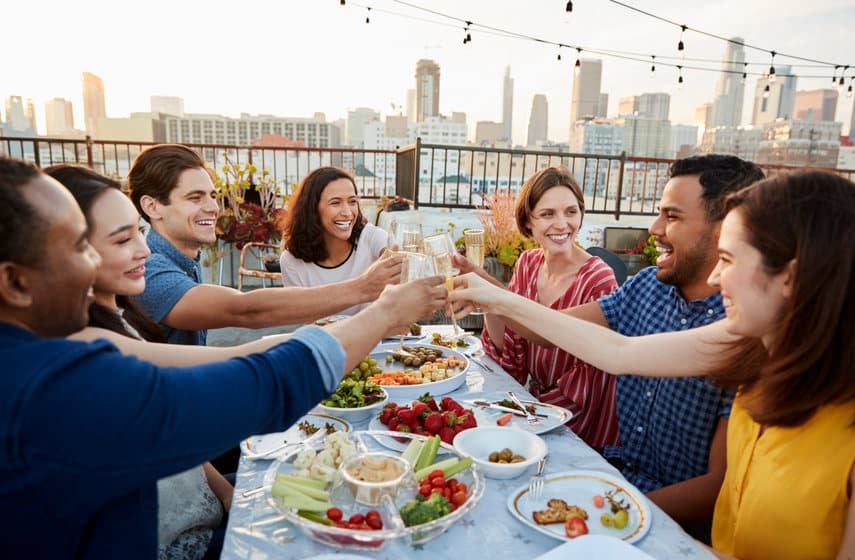By Jessica Scarpati –
You’re scanning the menu at a restaurant and your eyes settle on what you’ve been craving. Maybe it’s a burger and fries. Perhaps it’s pizza. Calories be damned. I’m going to treat myself, you tell yourself. But then more health-conscious dining partners start saying things like, “I think I’ll have a kale salad” and “Oh, yeah, that veggie platter sounds good.”
Second guessing is natural. Without it, chances are that next meal of whatever will be served on a bed of watercress. Sound familiar? It should. Studies have shown that food choices are heavily influenced by whoever else is sitting around the table. Worse still, the influence cuts both ways. In fact, people who are trying to make more nutritious choices are susceptible to opting for unhealthy meals when surrounded by dining partners who choose fatty foods.
A recent study examined the eating habits of approximately 6,000 employees at a Massachusetts hospital, tracking the purchases of those who used payroll deduction via their hospital ID badges to pay for meals at the hospital cafeteria.
“We found that individuals tend to mirror the food choices of others in their social circles, which may explain one way obesity spreads through social networks,” says public health researcher Douglas Levy, first author on the study.
Food and beverages sold in the hospital cafeteria have a “traffic light” labeling system to encourage nutritious choices—green for “healthy,” yellow for “less healthy” and red for “unhealthy”—allowing the research team to easily categorize purchases. From there, they looked at long-term patterns in the timestamps of card swipes, and later validated those findings with employee surveys. The team also crunched the data from numerous perspectives to control for the “birds of a feather flock together” theory, known as homophily, and consistently found that people’s social networks, not pre-existing food preferences, influenced meal choices.
What’s eating away at people when they make these decisions? Often, it’s as simple as peer pressure, Levy explained.
“People may change their behavior to cement the relationship with someone in their social circle,” he said.
Even the quantity of food we consume is affected by those around us. In other words, you may be more likely to give yourself permission to take a second helping or order that extra appetizer when sharing a meal versus dining solo.
“Research has shown that we eat more with our friends and family than when we eat alone and the quantity of food increases as the number of fellow diners grows,” according to the European Food Information Council.
Scrolling through Instagram while figuring out what to do for dinner may not be any safer, according to experts, who say social media is an equally powerful influencer on our food choices—even when we’re alone.
Another recent study found that Facebook users were likely to mirror what their perceived to be their online peers’ eating habits. That is, people who saw photos of friends on social media chowing down on donuts, pizza and burritos—and believed that’s what their peers consumed regularly—themselves reported eating about a third more junk food.
But chew on this: The opposite was true too. People who believed their Facebook friends ate ample fruits and vegetables also ingested a little more produce themselves.
“We may be influenced by our social peers more than we realize when choosing certain foods. We seem to be subconsciously accounting for how others behave when making our own food choices,” said food psychology researcher and study author Jason Thomas. “So, if we believe our friends are eating plenty of fruit and veg, we’re more likely to eat fruit and veg ourselves. On the other hand, if we feel they’re happy to consume lots of snacks and sugary drinks, it can give us a ‘license’ to overeat foods that are bad for our health.”
In an earlier study, Thomas and his colleagues sought to turn this whole phenomenon on its head by seeing if they could prompt people to make healthier food choices through the power of suggestion.
Researchers asked college students in a laboratory to evaluate a poster: One group viewed a poster displaying survey results that showed their peers liked eating fruits and vegetables every day, while the other group was shown a poster with unrelated facts about their university. Next, they were asked to eat and rate snacks, both healthy (cucumbers and grapes) and unhealthy (cookies and chips). Students who had viewed the first poster, which normalized healthy eating, were more likely to eat the nutritious snacks.
The findings led researchers to wonder if public health organizations should take a page from, say, movie theaters—where consumers are bombarded with enticing images of people enjoying salty, fatty snacks—and employ more positive peer pressure.
“It might be more effective in terms of health promotion to highlight how much other people enjoy eating fruit and vegetables than to tell people that they should because it is good for them,” Thomas said.













